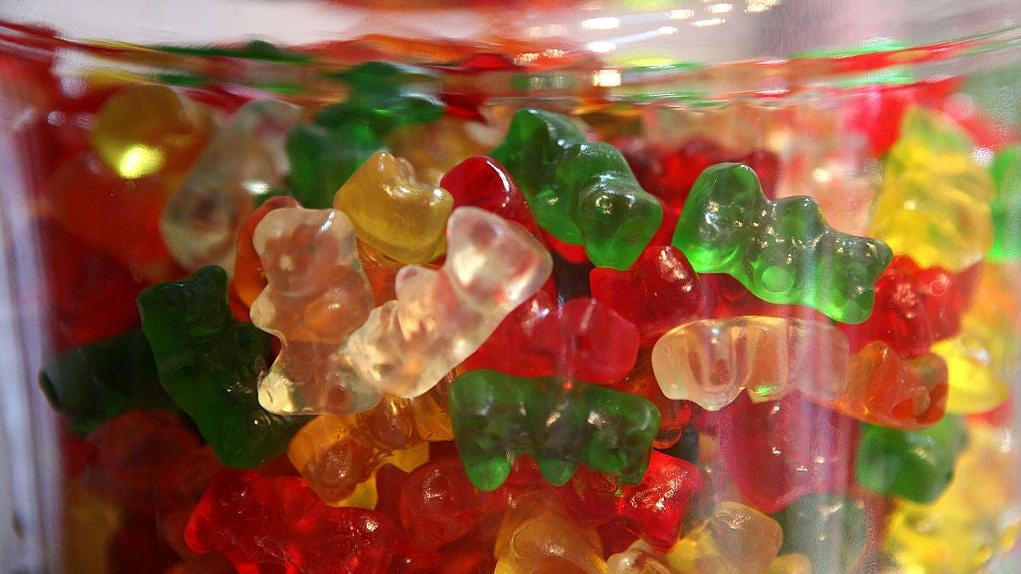All Our Burning Questions About Haribo Gummy Bears, Answered
Why a bear? Why are the strawberry ones green? Will there ever be an American factory?
We may receive a commission on purchases made from links.
Why, of all the animals in the world, was the first gummy a bear? And why on earth did this question never even occur to me until a couple of weeks ago at the Sweets & Snacks Expo in Indianapolis when I was sitting with two representatives from Haribo, the company that, exactly 99 years ago, brought the world the gummy bear?
I can't answer the second question, except that maybe because I grew up with gummy bears, they just seemed inevitable; worms were a funny parody. The answer to the first question, though, lies in the childhood of Hans Riegel, the German confectioner who founded Haribo in 1920. (He invented the company's name by taking the first two letters of his first and last names, plus Bonn, his hometown.)
"In Germany back then," explained Rick LaBerge, Haribo's COO, "there were dancing bears at the circus. They brought joy. Rigel wanted to mimic that."
The original Haribo bears were much larger than the bite-sized gummies we have today. But children were always encouraged to play with them, says LaBerge. The Haribo company is all about childlike happiness—hence the company's current TV ad that shows adults in a corporate boardroom discussing gummy bears while speaking in children's voices. (The Japanese version of the ad features sumo wrestlers.)

Next year marks the centennial of the iconic Goldbear (no, "iconic" is not too strong a word), and Haribo will be celebrating by selling lots of gummies in new and exciting flavors—which LaBerge and his colleague Jennifer Millns, a communications specialist, did not discuss since there are already so many new and exciting shapes and flavors this summer, including Watermelon, Peaches, Twin Snakes, and a Funtastic Mix that contains not just bears, but also dinosaurs. There will also be sneakers later this year, a collaboration with Puma. Several Haribo staffers at the expo were already wearing them, and they proudly showed off the gummy bears embedded in the sole (see photo above).
Haribo will also be celebrating the Goldbear centennial by building itself a big new factory in Pleasant Prairie, Wisconsin, just an hour drive from Takeout world headquarters in Chicago. This will be Haribo's 18th factory, but, crucially, it will be the company's first in North America, although Haribo has been selling gummies here since 1982. LaBerge said there would be "some sort of experience" for visitors, though it has yet to be determined what, exactly, that experience will be. The new factory will create 400 jobs in southern Wisconsin.
Haribo will not be embracing the legalization of recreational weed across the U.S. But why were gummy bears used as edibles in the first place? (Another question that never occurred to me!) "It's easy to spray THC onto this type of product," LaBerge told me confidently. "But gummy edibles now are nondescript squares and spraying gummy bears is forbidden. We never want to have a person flip out [after eating one of our products]."
This was good to know. But LaBerge continued, explaining that Haribo would never make sugar-free products, either. "Too much sugar-free product can act like a laxative," he said. (This was proven in an especially vicious Amazon review that claimed to be about Haribo Goldbears but was actually of Albanese bears.) Since Haribo is all about childlike joy, the company tries to limit excessive sugar consumption by selling gummies in smaller packets instead.
There was one final question that needed to be answered: Why are the green Goldbears strawberry flavored? That answer lies far back in the mists of time, before raspberry flavoring was coded blue. Cherry was dark red. Raspberry was lighter red. That left nothing left for strawberry, except for green, which maybe matches the leaf on top of the berry so it kind of works? Or consider it a special quirk for people to show off how in the know they are about the gummy world.
